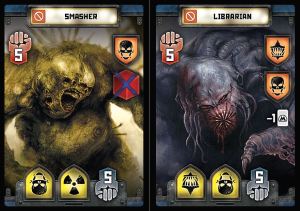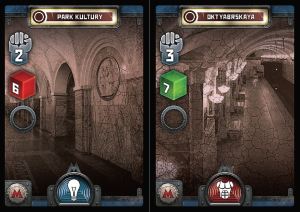-
 Designer: Evegny Nikitin
Designer: Evegny Nikitin
- Publisher: Hobby World
- Players: 2-5
- Time: 45 minutes (though I’d say it’s about 15 minutes per player)
- Ages: 12
- Times Played: 4 (with review copy of provided by Hobby World)
Dystopian
visions of the future are all the rage in film (The Hunger Games,
Divergent, Children of Men), in literature (The Giver, The Passage), in
video games (Half-Life/Portal, EVE Online) and in board games (Arctic Scavengers, Bioshock: Siege of Columbia).
At some level, the whole zombie mania (please, no more games about
zombies – I beg you!) has elements of dystopia – and, in many cases, a
severe lack of imagination.
The previous paragraph needs footnotes:
- Yes, I’m aware that The Passage is a zombie book of sorts… I loved the first couple hundred pages & then completely bogged down when time shifted.
- Yes, I’m also aware that there’s a lot of crossover between various media formats in my examples above.
- No, I’m not likely to get over my dislike of zombies any time soon.
In Metro 2033: Breakthrough, players take control of and attempt to grow one of the factions who lives in the subway system. By hoarding resources, occupying stations and successfully defending against attacks from the Dark Ones, the factions grow from mere survival to dominance… and the win!
Game Play
Each player begins with five faction tokens placed above his faction card. These represent your forces that you can send into the underground to scavenge for resources and locate new stations. They are also the measure of victory – if you manage to grow your faction to 10 tokens, you have successfully mustered the support of the residents of this post-apocalyptic world. Players are also dealt a hand of five cards.
On a turn, a player can do one of three things:
- play a card into his tableau, paying the cost of the card by taking tokens from above his faction card and sliding them below the card.
- discard a card and return tokens from below his faction card to above the faction card equal to the cost of the discarded card.
- discard three cards from his hand and draw three new cards
 Players can play four different types of cards into their tableau:
Players can play four different types of cards into their tableau:- Resources:
from air scrubbers to automatic weapons, Resource cards have a value of
1, 2 or 3, which is applied to faction quests and settling stations.
They come in two colors in 3 “suits” each:
- Peaceful (blue) resources: Welfare, Food & Items
- Military (red) resources: Weapon, Bullets & Equipment
- Heroes: what would your dystopian world be without heroes to brave the wasteland? In Metro 2033: Breakthrough, Hero cards offer two benefits when played:
- Stations: Station cards give a discount on one “suit” of Resource cards immediately – and when finally settled, make that particular type of Resource free to play. As well, when they’re settled, they add more faction tokens to a player’s tableau.
- Threat Protection: certain Resource and Threat (monster) cards can be played as Threat Protection cards by paying their faction token cost and playing them with their yellow shield(s) facing up. When a Threat attacks, a player can discard a Threat Protection card with the matching symbol to both prevent damage from the attack as well as giving him an out-of-turn card play with no faction token cost.
- Caravans: this clears the 3 card draw display as well as potentially allowing players with completed faction quests and/or settled stations to return back faction tokens.
- Threats: monsters lumber out of the darkness to destroy supplies and take back stations.
 Threats
affect every faction – even the one that played them – if you are
unable to defend, you lose whatever is indicated on the card. (The
monsters that take away both blue & red resources can be
particularly nasty.) If you can defend, you receive the aforementioned
“free” out-of-turn play. If a station is taken away, the faction token
moves to the faction card.
Threats
affect every faction – even the one that played them – if you are
unable to defend, you lose whatever is indicated on the card. (The
monsters that take away both blue & red resources can be
particularly nasty.) If you can defend, you receive the aforementioned
“free” out-of-turn play. If a station is taken away, the faction token
moves to the faction card.Play continues until one faction reaches ten faction tokens – indicating a critical mass of followers and supplies that allows them to gain control of the Metro and win the game.
So, How Is It?
I used to love “take that” games… in fact, another dystopian classic and personal favorite of 20 years ago, Illuminanti (and the CCG version, Illuminati: New World Order), are both basically old school “take that” card games dressed up in some gamer-y chrome. As I’ve grown older, that particular game mechanism is less appealing to me.
So I started playing Metro 2033: Breakthrough with a bit of trepidation – would the monsters overwhelm any chance to build up resources & stations? So far, that hasn’t been an issue, thanks to a clever design choice: monsters affect every faction, even the one that set them loose. This makes putting monsters into play something not to be taken lightly.
That said, I can anticipate that certain groups would be, shall we say, “monster-happy” and make the game run unnecessarily long with a succession of rampages. My solution: play King of Tokyo with those people rather than Metro 2033.
I am also concerned that a five player game (which we have not played) would have a tendency to increase the number of monster cards in circulation by the virtue of the deck size. We circled through the deck one and a half times when playing with 4 players – with five, that would easily reach two trips through.
Speaking of number of players, I was pleasantly surprised that the game worked well with 2, 3, and 4 players. It lacks a little “oomph” with 2 – but the design doesn’t bog down and it’s an enjoyable filler for a couple of folks who don’t mind the theme. It’s more of a super-filler (45 minutes or so) with 3 or 4 players.
The artwork is evocative without being obnoxious or overdone. As well, the iconography is clear and easy to use once you have a game under your belt.
 Metro 2033: Breakthrough has
one other trait I really enjoy in a game: it speeds up towards the end.
As players acquire more faction tokens and stations, they increase their
ability to find resources and settle stations. (Note: this is not only
good game design, it’s thematically solid.) In addition, this speedy
ending hasn’t (so far) caused any blowouts – we’ve had a couple of very
close finishes and a couple of wins that were a little more obvious, but
no one has been left completely in the dust.
Metro 2033: Breakthrough has
one other trait I really enjoy in a game: it speeds up towards the end.
As players acquire more faction tokens and stations, they increase their
ability to find resources and settle stations. (Note: this is not only
good game design, it’s thematically solid.) In addition, this speedy
ending hasn’t (so far) caused any blowouts – we’ve had a couple of very
close finishes and a couple of wins that were a little more obvious, but
no one has been left completely in the dust.Metro 2033: Breakthrough wears its theme well… and it’s a very playable and enjoyable super-filler with a core mechanism (the ebb & flow of spending tokens) that’s both thematically evocative and an interesting design choice.
This review originally appeared on the Opinionated Gamers website...



No comments:
Post a Comment